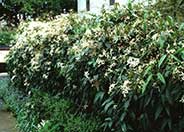
Common name:Kleinia
Botanical name:Senecio mandraliscae
This succulent perennial will grow to about 1.5' tall and 2' wide. It has curved, bluish gray leaves that are about 3.5" long and very slender.

Common name:Mexican Palo Verde, Jerusalem Thorn
Botanical name:Parkinsonia aculeata
The Mexican Palo Verde has prickly stems. This tree is very fast growing with sparse foliage and very long narrow leaves. Yellow flowers with orange red throats bloom sporadically. It is very messy, thorny, weedy and short-lived. This tree is usually found on limestone soils in areas with moisture but is strongly drought tolerant. It can withstand saline conditions. It can be cold or drought deciduous. It is beautiful in form being light and airy looking, with green bark.

Common name:Australian Tree Fern
Botanical name:Cyathea cooperi
This evergreen fern reaches a height of 10' with light green fronds that spread to a width of 15'. Its fronds are wider and held more horizontally than those of the Tasmanian fern tree. It requirs part shade to shade, with average to little summer watering. This plant performs well in containers, and is damaged by frost below 25 degrees F.

Common name:Bougainvillea selections
Botanical name:Bougainvillea cultivars
This species is hardy and vigorous, with a showy, ornamental display of purple color. It blooms well in areas with cool summers.
It is senstive to frost and will die back hard but comes back in a number of weeks. Be carefeul of this in the Santa Ynez Valley.

Common name:Indian Hawthorne
Botanical name:Rhaphiolepis indica
This small shrub will grow 2' tall and 4' wide. It has small, dark green leaves that get a red tint in the winter and deep pink flowers that bloom fall through spring.

Common name:Evergreen Clematis
Botanical name:Clematis armandii
A climbing evergreen vine, this Clematis may reach a size of 20'-30'. Its dark green, slender leaflets have a leathery texture, and produce fragrant, showy white flowers in the spring. It tolerates sun or part shade, drought, moist soil, and prefers shade around its roots. It attracts beneficial insects and hummingbirds.
Designer: Isabelle Greene
Photographer: GardenSoft
Practice grass-cycling by leaving short grass clippings on lawns after mowing, so that nutrients and organic matter are returned to the soil.
Attract, or buy beneficial insects such as ladybugs and lacewings to control pest outbreaks in your garden.